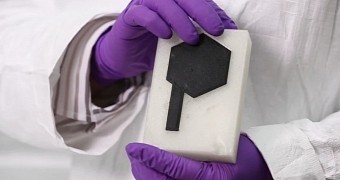We probably don't need to make a flamboyant introduction for graphene, but just in case you're not up to date on it, know this: the material is considered the basis for the next technological great leap.
It's still not clear when that great leap will happen. It could be years and it could be a decade or more. The people at Graphene 3D Lab Inc. hope for the former though.
What's more, they think they can become a major part of the so-called transition, having created a 3D printing technology capable of producing batteries, of all things.
Previously, we would mostly hear about graphene-based processors and storage devices, but power-generation and conducting applications appear to be taking precedence. Research must be easier and cheaper to carry out here we suppose.
The Graphene 3D printed battery
Graphene 3D Lab Inc.’s CEO Daniel Stolyarov revealed, during the Inside 3D Printing Conference in Santa Clara, that the company managed to 3D print a functional prototype of a graphene battery.
Although calling it that is a misnomer, because the graphene only makes up 10 percent of the new nanocomposite filament created by the corporation. The rest is thermoplastic material.
Anyway, the prototype is a zinc-air battery, although the company intends to make lithium-ion batteries in the future.
The end goal is to create graphene-based, or at least partially graphene-based, batteries and other electrochemical devices. It wasn't SLS but a FDM printer that was used to produce the new prototype though.
The main challenges of a graphene 3D printed battery
Mostly, the difficulty stems from how the prototype is made of five different graphene composite materials, meaning that the 3D printer needs to have five hotends. FDM printers like this don't exist on the market at present. Graphene 3D Lab is actually working with manufacturers to make one. Alas, no ETA was given for when we'll see it.
In the future, the outfit means to come up with nanocomposite powders suitable for selective laser sintering as well. The market for that is too small compared to thermoplastics though, so it's not an immediate focus.
What graphene is
Basically, it's a sheet of shaved graphite. Carbon atoms arranged in a hexagonal, planar array. Scientists have found that different applications of the molecular layers can lead to superconductors, highly capacious storage devices, very fast processors and combinations thereof. In a way, it can change how products with integrated electrical components are made and used.
And since the material is also very strong, it can allow for much taller and tougher buildings as well.

 14 DAY TRIAL //
14 DAY TRIAL // 